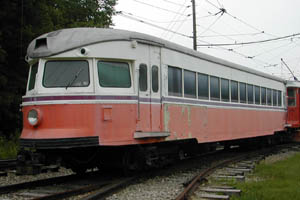
- Builder
- J. G. Brill Co.
- Description
- 'Bullet' car
- Secondary Use
- None
- Type
- Interurban Cars
- Year
- 1933
- Retired from Service
- 1991
- Acquired by the Museum
- 1991
- Note
- No. 203 is stored outdoors awaiting further restoration.
- Fund
- 846
SEPTA 203
From Philadelphia, Pennsylvania
History
The Philadelphia & Western Ry. began operating in 1907 with an 11-mile, third-rail powered line from 69th Street in Upper Darby, PA to Strafford, PA. At 69th St., on the western boundary of Philadelphia, the P&W connected with the Philadelphia Rapid Transit’s elevated line to center city Philadelphia. In 1912, the P&W opened a branch from Villanova to Norristown. The 13.5-mile 69th St. to Norristown route became the main line and connected at Norristown with the Lehigh Valley Transit’s interurban line to Allentown. Lehigh Valley Transit No. 1030, now also at Seashore, ran on this route from 69th St. to Allentown between 1941 and 1951, using the P&W on the southern section between 69th St. and Norristown.
In 1930, the P&W responded to a sharp drop in revenues by turning management over to Dr. Thomas Conway, Jr. who had just revitalized the Cincinnati & Lake Erie interurban. Conway joined with the J.G. Brill Company to design new equipment that would improve service and reduce costs. To design a vehicle with reduced wind resistance, Conway and Brill hired a University of Michigan aeronautics professor to test models in a wind tunnel. The result was a streamlined, lightweight, all-aluminum “bullet” car with a low roof and free of clutter. In 1931, Brill built 10 “bullet” cars, Nos. 200-209, for the P&W at a cost of $31,000 each. The “bullet” cars cut power costs by 43% and reduced the running time on the Norristown line from 24 minutes to 17 minutes. While the “bullet” cars were successful in increasing ridership and reducing costs, they suffered from unsatisfactory ride quality. Frequent stops on the route required the P&W to change brake shoes once a week. The “bullet” cars were the first streamlined electric cars in the U.S., the first all-aluminum cars and the first to have used extensive wind tunnel tests. This design predated the first steam railroad streamliners by several years and foreshadowed the streamline style that became popular for many products later in the 1930s. Brill hoped the “bullet” car would modernize and save the remaining interurban industry, but Brill sold only five other cars, to New York’s Fonda Johnstown & Gloversville Ry.
The P&W painted its “bullet” cars dark red with gold lettering and ran them exclusively on the Norristown line. In 1933, a fire destroyed No. 203. Brill quickly replaced the car with a new car, also numbered 203. This is the car now at Seashore. In 1948, the Philadelphia Suburban Transportation Co. acquired control of the P&W. The PSTC, known as the “Red Arrow” Lines, operated trolley lines out of the same 69th Street terminal to other Philadelphia suburbs. In 1953, the P&W merged into the PSTC. In 1963, the PSTC acquired the Chicago North Shore & Milwaukee’s two Electroliner streamliners to supplement the “bullet” cars on the Norristown line. In 1970, the Southeast Pennsylvania Transportation Authority, a state agency, acquired the PSTC and repainted the “bullet” cars into SEPTA’s scheme of white and orange with blue stripes, sometimes termed the “Gulf Oil” paint scheme. In the early 1980s, SEPTA repainted the “bullet” cars again, this time in SEPTA’s red, white and blue paint scheme. In 1987, SEPTA began replacing “bullet” car service with used rapid transit cars from Chicago. In 1991, SEPTA finally retired the “bullet” cars after a remarkable 60 years in service (58 years for No. 203). The cars’ route has some characteristics of a rapid transit line, but, if considered an interurban, the line joins the Chicago South Shore & South Bend as the nation’s only surviving interurbans, due in large part to the success of the “bullet” cars.
At their retirement in 1991, Seashore purchased at auction three “bullet” cars: No. 203, No. 207 and No. 208. No. 207 had been wrecked and was acquired for parts. In 1986 or 1989 (sources differ), SEPTA had sent No. 203 to its Woodland Overhaul Facility for structural repairs. No. 203 had some collision damage. So, SEPTA installed some steel and aluminum structural members. SEPTA removed a door, windows and some side panels but halted further repairs. No. 203 was still partially disassembled when Seashore acquired the car.
In 1996 Seashore did a cosmetic restoration which included replacing the windows and door and installing plywood and galvanized steel side sheathing. The museum applied the orange and white “Gulf Oil” paint scheme and placed No. 203 on display for a few years at the museum entrance on Log Cabin Road.
Another “bullet” car, No. 205, is under restoration at the Rockhill Trolley Museum at Rockhill Furnace, PA. In 2025, Seashore agreed to let Rockhill take some parts off “bullet” cars Nos. 207 and 208 for Rockhill to use in restoring their No. 205. At this time, using a magnet, Rockhill members checked whether No. 203 was built of steel or aluminum. Sources generally reported that the replacement 203 was built of steel, unlike the aluminum used for all the original “bullet” cars, but Rockhill’s analysis indicated that Seashore’s No. 203 is mostly aluminum. Lacking detailed records of No. 203’s various repairs over its lifetime, it is difficult to determine the original body material.
Technical Information
- Seats: 56
- Control: PC-12 (C-129)
- Brakes: SME (M35)
- Compressor: DH-20
Trucks
- Number: 2
- Manufacturer: Brill
- Model: 89E-2
Motor
- Number: 4
- Manufacturer: General Electric
- Model: 706B2
Weight and Dimensions
- Length: 55’
- Width: 9’ 1.00"
- Height: 10’ 6.00"
- Weight: 52290 lbs.
Additional Images

Sister car 200 in Philadelphia suburbs in 02/1971 - Joe Testagrose at newdavesrailpix.com
© 1998 - 2025 New England Electric Railway Historical Society. All Rights Reserved.